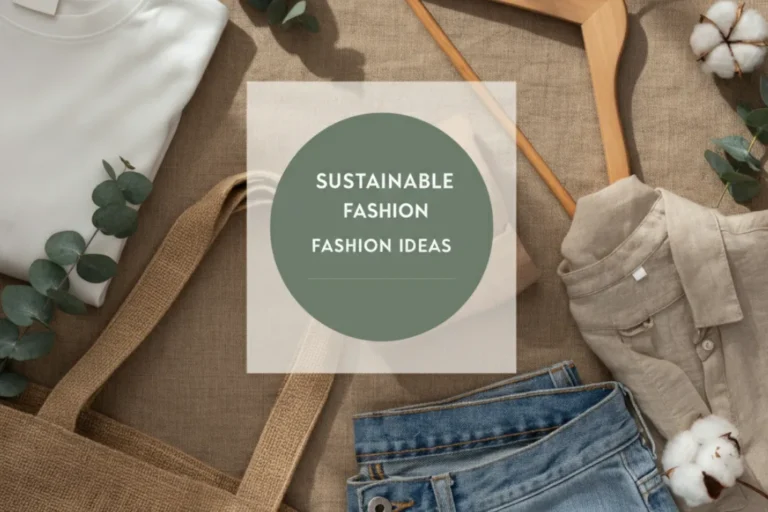What do your clothes really say about you? Fast fashion has changed the way we shop, but it’s also filled our closets with pieces we rarely wear and added to the world’s waste. You don’t need to be an environmental activist to make a difference—everyday changes start in your own wardrobe. These sustainable fashion ideas are for anyone who wants to look good, spend less, and make better choices for the planet.
Build a Capsule Wardrobe
Ever open your closet and feel like you have nothing to wear? Creating a capsule wardrobe solves that. It’s all about collecting a handful of high-quality essentials you love, so every item has a purpose. A capsule focuses on versatility—think neutrals, well-made basics, and pieces that work year-round.
Define Your Personal Style
Know what makes you feel comfortable and confident. Take inventory of your favorite outfits and notice patterns—colors you always reach for, cuts you like, and fabrics that feel good. Knowing what actually works for you keeps you from chasing every new trend.
Invest in Timeless Staples
Aim for those items you’ll love year after year: crisp white shirts, fitted jeans, a solid pair of boots, or a classic coat. Pieces like these handle heavy rotation and never go out of style, making them core to any sustainable wardrobe.
Choose Sustainable Fabrics
Choosing what your clothes are made from can have a huge impact. Look for eco-friendly and ethical fabrics that last, feel great, and respect the environment. When you shop, scan the tags for:
Prioritize Natural and Organic Fibers
- Organic cotton: grown without chemicals, easier on skin, and trusted in the eco-fashion world.
- Hemp: strong, soft, uses very little water, and is naturally pest-resistant.
- Linen: made from flax, lightweight, long-lasting, and biodegradable.
- Bamboo: requires fewer resources and has a gentle touch.
Explore Innovative Eco-Materials
Some new fabrics are changing the game:
- TENCEL™ Lyocell: smooth, breathable, and produced with minimal waste.
- Recycled polyester: transforms old plastic bottles into wearable, durable fabrics.
- Econyl: regenerated nylon made from ocean and landfill waste.
Embrace Secondhand and Rental Fashion
Secondhand shopping is no longer just for thrifters—everyone’s getting in on the fun. It saves money and keeps clothes in circulation instead of landfills.
- Local thrift shops: Dig for treasures in charity and vintage stores.
- Online resell platforms: Apps like Depop, Poshmark, and ThredUP are packed with hidden gems.
- Clothes swaps: Organize an exchange with friends. You’ll get a new look without spending a dime.
- Rent when you need it: Skip buying that one-time outfit. Try renting special occasion pieces.
Master the Art of Care and Repair
Take care of what you own and your wardrobe will reward you. A little effort means your favorite clothes stick around much longer—and you buy less over time.
- Wash clothes only when truly needed and opt for cold water to save energy.
- Mend small holes, fix buttons, and patch up small tears—basic sewing goes a long way.
- Hang or fold clothes properly, and let them air dry when possible.
Upcycle and DIY Your Wardrobe
Don’t toss that shirt just because it’s faded! Give it new life by turning it into something else or customizing it with a DIY twist.
Get Inspired with DIY Projects
Try hand-embroidery, iron-on patches, or re-dyeing old tops to refresh them. Craft sites and tutorials are full of creative ideas to upcycle what you already own. You’ll save money, reduce waste, and wear pieces that are uniquely you.
Conclusion: Wear Your Values
Fashion is one of the simplest ways to reflect what’s important to you. Embracing sustainable fashion ideas doesn’t mean sacrificing style or fun. Start small—choose better fabrics, take care of your clothes, or shop secondhand now and then. Every change, however small, moves you closer to a wardrobe you love and a planet you want to protect.
Want to dig deeper into how fashion impacts the environment? Check out this overview from the World Resources Institute for facts and tips on making positive changes.
Frequently Asked Questions
1. What’s one small way to start building a more sustainable wardrobe?
Start by wearing what you already own and get creative with mixing and matching. This cuts down waste and helps you appreciate the clothes you have.
2. Do ethical fabrics really make a difference?
Absolutely. Choosing materials like organic cotton or TENCEL™ helps cut back on pollution and supports responsible farming and production.
3. How can I be sure a brand is truly ethical?
Research their supply chain, check for certifications, and look for open information about labor and materials. Responsible brands make their ethics clear.
4. Can sustainable fashion be budget-friendly?
Yes! Thrift stores, secondhand markets, and clothing swaps are affordable. Investing in quality pieces pays off over time.
5. Why does laundry matter for sustainability?
Washing in cold water uses less energy and is gentler on fabrics, keeping clothes wearable for longer and reducing environmental impact.
.You may also read:Look Expensive on a Budget: Your Guide to Affordable Fashion



